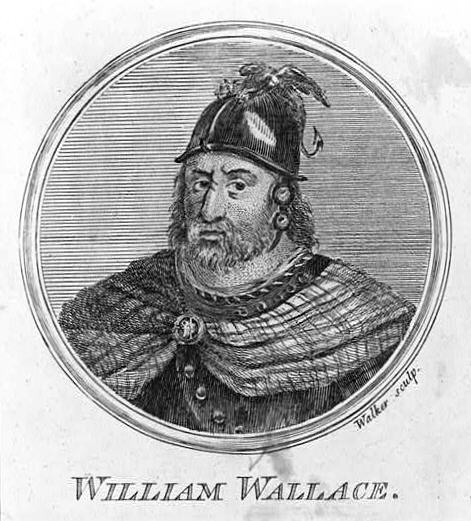
A stained glass window dedicated to William Wallace of Braveheart fame. The window is found in Edinburgh Castle.
In the Oscar-winning movie, Braveheart, the hero William Wallace of Scotland falls in love with Isabella, the daughter-in-law of England’s Edward I. William Wallace and Isabella are both real people from history, but there was one slight problem with their relationship.
In real life, Isabella was only a baby at the time of William Wallace.
People shouldn’t get their history solely from dramatizations, whether we’re talking about historical novels or movies. I love dramatic portrayals of history, and I have written several historical novels, but be aware that what you see or read is not what always happened.
This is particularly true in film, where many liberties are taken to jam a story into two hours, to heighten tension on the screen, or to introduce a love story that doesn’t exist, as in Braveheart. As another example, take the Disney animated film, Pocahontas. The movie depicts the explorer John Smith falling in love with the Native American maiden, Pocahontas, but historians say this never happened. Pocahontas was only eleven years at the time, although she did go on to marry a British man—John Rolfe, not John Smith.
Evidently, love means never having to be historically accurate.
So, as a writer of historical fiction, how much liberty should you take to tell a good story?
When I started out, I tried to be as historically accurate as possible. When I first came upon the story of Henry “Box” Brown, my goal was to depict only those scenes from his life that were mentioned in Brown’s two first-person narratives, one written in 1849 and the other in 1851. (Henry Brown was a slave who escaped in 1849 by shipping himself in a box from Richmond, Virginia, to Philadelphia.)
However, a fiction-writing/screenwriting teacher changed my opinion about historical purity by convincing me not to be so rigid about sticking to only historically known facts. Many aspects of a person’s story are not known and never will be known, but they are critical to a story, she explained. So you sometimes need to create scenes from thin air.
For instance, in my first historical novel, The Disappearing Man, the relationship between Henry Brown and his wife Nancy was vital to the story. After all, the reason Henry decided to escape from slavery was because his wife and children were sold away from him. If that tragedy in his life was going to have any emotional impact, the reader had to see and feel their relationship. But the problem I faced was that we know absolutely nothing about their courtship.
So what’s a writer to do?
I could speculate about their relationship, that’s what I could do.
So I went ahead and created courtship scenes between Henry and Nancy—entirely fictional chapters. But I still tried to anchor these scenes in historical reality. For instance, slaves and free blacks in Richmond actually did organize a fancy dress ball in one of the city’s hotels, so I created a scene in which Henry and Nancy attended this ball (although I changed it to a fancy dinner party because Henry and Nancy attended a Baptist church, where dancing was frowned upon).
As I wrote my first historical novel, I learned how important it was to fill in the blanks, providing critical information that we just do not know. In doing this, however, I have tried to follow one golden rule. I do not change history. I fill in the blanks, speculating on what could have happened, but I don’t change known facts.
I made one exception to this rule in my four novels, but I won’t get into the reasoning behind it here. Other than that one instance, I have not changed facts—only added to a story, such as creating courtship scenes. So I would never have a historical character fall in love with a person who was actually a baby in real life. That’s changing the facts too much for my taste.
Also, I always end each of my historical novels with an Author’s Note, in which I try to give the reader a sense for what is fact and what is fiction. This Author’s Note sends a clear message: Not everything you read here is Gospel truth.
Even non-fiction books are not always true to history because many writers have a way of twisting history to suit their own views. So the bottom line: To understand history, we all have to do our homework.
* * *
5 for Writing
- Get writing. Find the time to write. Then do it.
- Learn by listening—and doing. Solicit feedback, discern what helps you.
- Finish your story. Edit and rewrite, but don’t tinker forever. Reach the finish line.
- Thrive on rejection. Get your story out there. Be fearless. Accept rejection.
- Become a juggler. After one story is finished, be ready to start another. Consider writing two at once.







3 Comments
I think that one important way in which fiction often fails is to depict to complexity of history and of those involved in it. Too often, many stories try to reduce events to a simple matter of ‘goodies vs baddies’, one side or group as inherenly good and the other as inherently evil. Real life, and real history seldom works that way.
There are often less than admirable persons, motives and actions on both sides, but also ‘baddies’ doing things we might not define as bad.
Movies like Braveheart which vilify one side, and make out the other to be entirely perfect, moral and admirable to do not help enhance anyone’s understanding of the complexity of the past. Doing so to serve the agenda of the author or film-maker though, it even worse.
I agree. In fact, just this week I read an online list entitled something to the effect of “10 Movies That Don’t Hold Up Today.” The list included “Braveheart” as a movie that doesn’t hold up today for the very reason you give. This writer argued that the story left out a lot of the historical complexity in favor of pitting the good versus the bad. It’s been a long time since I actually saw “Braveheart,” so I may need to rewatch it to see what I think of it today.
Thank you so much for this article. I have finished and am now self publishing a children’s historical fiction of Tsali. Tsali is the reason there is an Eastern Band Cherokee in NC. Very little is known about Tsali and the details of the conflict are hard to unravel from Cherokee oral accounts and US gov accounts. I researched all I could find but there were still a lot of gaps that I had to fill. Your article helped ease my concerns that I had committed an offence to history by trying to turn an important event into a readable story for children.